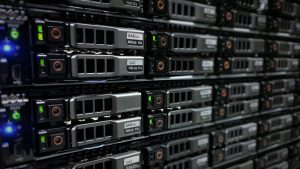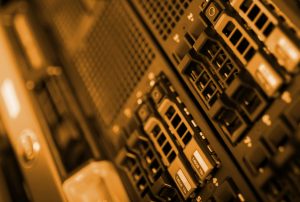Archive for August, 2016
RAID: Why Your Server, Website and Business Needs It no comments
As hard drives have grown in capacity, backing entire systems up to non-volatile media such as tape has grown increasingly impractical. The amount of tape required to maintain a seven-day rotating backup of a modest server with only a few hard drives, for example, is financially unfeasible for most businesses.
So, what do most businesses do? They compromise. They back up all of their data to a single set of tapes — and if you encounter a failure with your one set of tapes during the data recovery process, you’ve got a catastrophe on your hands. It’s better than not backing data up at all, but only marginally. Which brings us to RAID.
RAID: A Better Solution
A Redundant Array of Inexpensive Disks (RAID) is a system that utilizes multiple hard drives simultaneously to act as a single storage volume. Using a controller that manages the operation of the hard drives, you can configure a RAID array to do the following:
- Stripe data across multiple drives, reading and writing data across all drives simultaneously for double the performance — or more — when reading or writing large blocks of data
- Mirror data across multiple drives so that each drive in the array contains an exact copy of the same data
- Create Parity blocks on each drive in the array, making it possible to recover the lost information if a drive fails — and to keep the array running while rebuilding the failed drive
RAID has several implementations — or “levels” — that utilize striping, mirroring, parity or a combination of the three. We’ll explain those more fully later in the article, but for now there’s one thing you need to know: If you have a home or business server, you need RAID. RAID is the one solution that can make your server faster, do a better job of protecting your data and continue operating while you rebuild data after disk failure.
RAID Levels
Although an exhaustive list of all RAID levels is outside the scope of this article, this brief list should help to explain the features and benefits of RAID in greater detail.
RAID 0 (Striping)
A RAID 0 array requires at least two hard drives. In RAID 0, the controller splits all data equally across all hard drives. Each drive works simultaneously during read and write operations, increasing the speed of the volume to far greater than that of a single hard drive.
Strengths and Weaknesses: A RAID 0 array excels in increasing a server’s storage performance. However, all data in a RAID 0 array is lost if one drive fails. You can add additional drives to a RAID 0 array to increase its performance further, but adding more drives further increases the risk of failure.
RAID 1 (Mirroring)
In a RAID 1 array, every hard drive contains the same data and the controller writes to all drives simultaneously. A RAID 1 array provides excellent data redundancy because all of the data survives unless every drive in the array fails.
Strengths and Weaknesses: In addition to data redundancy, RAID 1 can slightly increase a server’s read performance. When the controller requests data, the drive that can access the data most quickly will retrieve it. However, RAID 1 provides no increase in storage capacity past that of the smallest hard drive in the array because each drive contains the same data. In addition, the slowest hard drive determines the write speed of the entire array.
RAID 5 (Parity)
A RAID 5 array stripes the data across multiple drives like RAID 0. However, every hard drive also carries parity data for each block written. Using the parity data, the controller can rebuild the entire array if one drive fails — and the array can continue working during the rebuild process.
Strengths and Weaknesses: The greatest strength of RAID 5 is that it offers increased reliability without sacrificing a great deal of storage capacity. Unlike RAID 1, the total capacity of a RAID 5 array increases each time you add a hard drive. However, parity data does take up some space. A RAID 5 array with four 1 TB hard drives will have a total capacity of about 3 TB.
RAID 5 offers better read performance than a single drive because the striping allows multiple drives to read simultaneously. However, the write performance of RAID 5 is relatively poor because of the extra time required to write parity data.
RAID 6 (Additional Parity)
RAID 6 is similar to RAID 5 in design, but it devotes an amount of storage equal to that of two hard drives — rather than one — to parity so it can tolerate the failure of two drives without losing data.
Strengths and Weaknesses: A RAID 5 array can tolerate the loss of any one drive. However, hard drive manufacturers state that about once every 12.5 TB, a hard drive will encounter an unrecoverable read error. If you have a RAID 5 array with four 4 TB drives and one drive fails, the remaining capacity of the array is about 12 TB. If one of the remaining three drives experiences a read error when rebuilding the array, the rebuild operation will fail. If you use more hard drives — or larger hard drives — the chance of failure is greater. So, RAID 6 is far more reliable than RAID 5 for very large RAID arrays. However, because RAID 6 doubles the amount of parity data, write operations are slower.
RAID 10 (Mirroring + Striping)
RAID 10, or RAID 1+0, is essentially the combination of RAID 1 and RAID 0. It combines disk striping and disk mirroring to provide redundancy and performance. Due to it’s incredible performance benefits, RAID 10 is one of the most ideal solutions, especially for intense applications and databases.
Strengths and Weaknesses: The greatest strength of RAID 10 is that it offers maximum performance while also maintaining redundancy. The only disadvantages of RAID 10 are that it requires a minimum of four disks and only 50% of the disk space is usable due to mirroring.
RAID has become a vital necessity for any business looking for safety and performance when it comes to their website and/or critical company data. If your business is currently running on a server without RAID, you risk not only data loss, but also the added performance that can separate you from your competitors. Now is the time to upgrade your business to a RAID solution. At TurnKey Internet, RAID upgrades are available on all of our Dedicated Servers. Best of all, our latest Best Value Dedicated Server already includes RAID 10, making your upgrade even easier! Start enjoying the added performance and safety of RAID today.
Follow Us :Share :
Dedicated Server: 4 Reasons Why Your Business Needs One no comments
Both large and small businesses are faced with a wide variety of choices and options when it comes to finding a server and hosting solution for their website, company email and data. One option is shared hosting, in which a single server’s resources are shared by a number of different websites and users.
However, if you’re a business looking for more power, control, and flexibility, the solution for you may be a dedicated server. With a dedicated server, your business has exclusive use of that server’s resources. You also have the flexibility of customizing the server’s CPU, RAM, and disk space based on the needs of your business.
Let’s take a look at 4 specific advantages of choosing a dedicated server:
No Shared Resources
When using a dedicated server, every bit of power, storage, and bandwidth is exclusive to you and no one else. Not only will this give your business more room to work with and expand, it will also prevent issues with your site caused by other websites. For example, if you’re site is hosted on a shared server where there is another website that is being attacked or hogging up resources, this can affect the performance of your company’s site.
Flexibility & Customization
A dedicated server allows your business to customize the hardware and software based on your company’s unique needs. Things like CPU, Memory, Hard Drive, even the speed of the server’s network port, can all be customized and upgraded on dedicated servers. With shared hosting, you are limited to the software already installed on the server, and sometimes it may lack a requirement or feature your business needs. But with a dedicated server, you have full flexibility over which software the server runs, even down to the Operating System.
Administrative / Root Access
Another downside of shared hosting is the lack of Administrative or root access to the server. This limitation affects what software you can install as well as the settings and options that you can configure on the server. This can greatly impact the potential of what you are able to do with your website. Another advantage of administrative/root access is the ability to better monitor and troubleshoot your website, with full access to the server’s logs.
Dedicated IP Address
Each dedicated server comes with its own dedicated IP address. With shared hosting, your site may be sharing an IP address with multiple websites. If your website happens to share an IP with a site that spams or contains malware, this can cause multiple problems. Your website can end up getting blocked, your email rejected as spam, even your search results can be affected. Another thing to consider is whether or not you’ll be running an e-commerce or selling things on your site. If so, you will need to have an SSL for your site, which in turn requires a unique dedicated IP.
Now if you’re worried that you’re not tech savvy enough to run your own dedicated server, consider the option of going with a Managed Dedicated Server solution, which will provide many additional benefits on top of what’s listed above. Also if cost is a concern, check out our latest ‘Best Value’ Dedicated Servers. There are countless other advantages to using a dedicated server, however the 4 above are some of the most notable. So before you decide to host your website on a shared server, consider the added flexibility, reliability, and performance that only a dedicated server can provide.
Follow Us :Share :
TurnKey Internet 2016 Expansion – Sneak Peak no comments
Ever wondered what goes inside those state of the art datacenters that run ‘the cloud’? Here is a sneak peak on day 1 as TurnKey Internet (https://turnkeyinternet.net) is expanding its New York Datacenter servicing the Capital Region with Colocation, Cloud Services and Disaster Recovery backup solutions.
More videos and pictures coming soon… Stay tuned!
Follow Us :Share :





